#example of Depth limited search
Explore tagged Tumblr posts
Text
AI “art” and uncanniness

TOMORROW (May 14), I'm on a livecast about AI AND ENSHITTIFICATION with TIM O'REILLY; on TOMORROW (May 15), I'm in NORTH HOLLYWOOD for a screening of STEPHANIE KELTON'S FINDING THE MONEY; FRIDAY (May 17), I'm at the INTERNET ARCHIVE in SAN FRANCISCO to keynote the 10th anniversary of the AUTHORS ALLIANCE.

When it comes to AI art (or "art"), it's hard to find a nuanced position that respects creative workers' labor rights, free expression, copyright law's vital exceptions and limitations, and aesthetics.
I am, on balance, opposed to AI art, but there are some important caveats to that position. For starters, I think it's unequivocally wrong – as a matter of law – to say that scraping works and training a model with them infringes copyright. This isn't a moral position (I'll get to that in a second), but rather a technical one.
Break down the steps of training a model and it quickly becomes apparent why it's technically wrong to call this a copyright infringement. First, the act of making transient copies of works – even billions of works – is unequivocally fair use. Unless you think search engines and the Internet Archive shouldn't exist, then you should support scraping at scale:
https://pluralistic.net/2023/09/17/how-to-think-about-scraping/
And unless you think that Facebook should be allowed to use the law to block projects like Ad Observer, which gathers samples of paid political disinformation, then you should support scraping at scale, even when the site being scraped objects (at least sometimes):
https://pluralistic.net/2021/08/06/get-you-coming-and-going/#potemkin-research-program
After making transient copies of lots of works, the next step in AI training is to subject them to mathematical analysis. Again, this isn't a copyright violation.
Making quantitative observations about works is a longstanding, respected and important tool for criticism, analysis, archiving and new acts of creation. Measuring the steady contraction of the vocabulary in successive Agatha Christie novels turns out to offer a fascinating window into her dementia:
https://www.theguardian.com/books/2009/apr/03/agatha-christie-alzheimers-research
Programmatic analysis of scraped online speech is also critical to the burgeoning formal analyses of the language spoken by minorities, producing a vibrant account of the rigorous grammar of dialects that have long been dismissed as "slang":
https://www.researchgate.net/publication/373950278_Lexicogrammatical_Analysis_on_African-American_Vernacular_English_Spoken_by_African-Amecian_You-Tubers
Since 1988, UCL Survey of English Language has maintained its "International Corpus of English," and scholars have plumbed its depth to draw important conclusions about the wide variety of Englishes spoken around the world, especially in postcolonial English-speaking countries:
https://www.ucl.ac.uk/english-usage/projects/ice.htm
The final step in training a model is publishing the conclusions of the quantitative analysis of the temporarily copied documents as software code. Code itself is a form of expressive speech – and that expressivity is key to the fight for privacy, because the fact that code is speech limits how governments can censor software:
https://www.eff.org/deeplinks/2015/04/remembering-case-established-code-speech/
Are models infringing? Well, they certainly can be. In some cases, it's clear that models "memorized" some of the data in their training set, making the fair use, transient copy into an infringing, permanent one. That's generally considered to be the result of a programming error, and it could certainly be prevented (say, by comparing the model to the training data and removing any memorizations that appear).
Not every seeming act of memorization is a memorization, though. While specific models vary widely, the amount of data from each training item retained by the model is very small. For example, Midjourney retains about one byte of information from each image in its training data. If we're talking about a typical low-resolution web image of say, 300kb, that would be one three-hundred-thousandth (0.0000033%) of the original image.
Typically in copyright discussions, when one work contains 0.0000033% of another work, we don't even raise the question of fair use. Rather, we dismiss the use as de minimis (short for de minimis non curat lex or "The law does not concern itself with trifles"):
https://en.wikipedia.org/wiki/De_minimis
Busting someone who takes 0.0000033% of your work for copyright infringement is like swearing out a trespassing complaint against someone because the edge of their shoe touched one blade of grass on your lawn.
But some works or elements of work appear many times online. For example, the Getty Images watermark appears on millions of similar images of people standing on red carpets and runways, so a model that takes even in infinitesimal sample of each one of those works might still end up being able to produce a whole, recognizable Getty Images watermark.
The same is true for wire-service articles or other widely syndicated texts: there might be dozens or even hundreds of copies of these works in training data, resulting in the memorization of long passages from them.
This might be infringing (we're getting into some gnarly, unprecedented territory here), but again, even if it is, it wouldn't be a big hardship for model makers to post-process their models by comparing them to the training set, deleting any inadvertent memorizations. Even if the resulting model had zero memorizations, this would do nothing to alleviate the (legitimate) concerns of creative workers about the creation and use of these models.
So here's the first nuance in the AI art debate: as a technical matter, training a model isn't a copyright infringement. Creative workers who hope that they can use copyright law to prevent AI from changing the creative labor market are likely to be very disappointed in court:
https://www.hollywoodreporter.com/business/business-news/sarah-silverman-lawsuit-ai-meta-1235669403/
But copyright law isn't a fixed, eternal entity. We write new copyright laws all the time. If current copyright law doesn't prevent the creation of models, what about a future copyright law?
Well, sure, that's a possibility. The first thing to consider is the possible collateral damage of such a law. The legal space for scraping enables a wide range of scholarly, archival, organizational and critical purposes. We'd have to be very careful not to inadvertently ban, say, the scraping of a politician's campaign website, lest we enable liars to run for office and renege on their promises, while they insist that they never made those promises in the first place. We wouldn't want to abolish search engines, or stop creators from scraping their own work off sites that are going away or changing their terms of service.
Now, onto quantitative analysis: counting words and measuring pixels are not activities that you should need permission to perform, with or without a computer, even if the person whose words or pixels you're counting doesn't want you to. You should be able to look as hard as you want at the pixels in Kate Middleton's family photos, or track the rise and fall of the Oxford comma, and you shouldn't need anyone's permission to do so.
Finally, there's publishing the model. There are plenty of published mathematical analyses of large corpuses that are useful and unobjectionable. I love me a good Google n-gram:
https://books.google.com/ngrams/graph?content=fantods%2C+heebie-jeebies&year_start=1800&year_end=2019&corpus=en-2019&smoothing=3
And large language models fill all kinds of important niches, like the Human Rights Data Analysis Group's LLM-based work helping the Innocence Project New Orleans' extract data from wrongful conviction case files:
https://hrdag.org/tech-notes/large-language-models-IPNO.html
So that's nuance number two: if we decide to make a new copyright law, we'll need to be very sure that we don't accidentally crush these beneficial activities that don't undermine artistic labor markets.
This brings me to the most important point: passing a new copyright law that requires permission to train an AI won't help creative workers get paid or protect our jobs.
Getty Images pays photographers the least it can get away with. Publishers contracts have transformed by inches into miles-long, ghastly rights grabs that take everything from writers, but still shifts legal risks onto them:
https://pluralistic.net/2022/06/19/reasonable-agreement/
Publishers like the New York Times bitterly oppose their writers' unions:
https://actionnetwork.org/letters/new-york-times-stop-union-busting
These large corporations already control the copyrights to gigantic amounts of training data, and they have means, motive and opportunity to license these works for training a model in order to pay us less, and they are engaged in this activity right now:
https://www.nytimes.com/2023/12/22/technology/apple-ai-news-publishers.html
Big games studios are already acting as though there was a copyright in training data, and requiring their voice actors to begin every recording session with words to the effect of, "I hereby grant permission to train an AI with my voice" and if you don't like it, you can hit the bricks:
https://www.vice.com/en/article/5d37za/voice-actors-sign-away-rights-to-artificial-intelligence
If you're a creative worker hoping to pay your bills, it doesn't matter whether your wages are eroded by a model produced without paying your employer for the right to do so, or whether your employer got to double dip by selling your work to an AI company to train a model, and then used that model to fire you or erode your wages:
https://pluralistic.net/2023/02/09/ai-monkeys-paw/#bullied-schoolkids
Individual creative workers rarely have any bargaining leverage over the corporations that license our copyrights. That's why copyright's 40-year expansion (in duration, scope, statutory damages) has resulted in larger, more profitable entertainment companies, and lower payments – in real terms and as a share of the income generated by their work – for creative workers.
As Rebecca Giblin and I write in our book Chokepoint Capitalism, giving creative workers more rights to bargain with against giant corporations that control access to our audiences is like giving your bullied schoolkid extra lunch money – it's just a roundabout way of transferring that money to the bullies:
https://pluralistic.net/2022/08/21/what-is-chokepoint-capitalism/
There's an historical precedent for this struggle – the fight over music sampling. 40 years ago, it wasn't clear whether sampling required a copyright license, and early hip-hop artists took samples without permission, the way a horn player might drop a couple bars of a well-known song into a solo.
Many artists were rightfully furious over this. The "heritage acts" (the music industry's euphemism for "Black people") who were most sampled had been given very bad deals and had seen very little of the fortunes generated by their creative labor. Many of them were desperately poor, despite having made millions for their labels. When other musicians started making money off that work, they got mad.
In the decades that followed, the system for sampling changed, partly through court cases and partly through the commercial terms set by the Big Three labels: Sony, Warner and Universal, who control 70% of all music recordings. Today, you generally can't sample without signing up to one of the Big Three (they are reluctant to deal with indies), and that means taking their standard deal, which is very bad, and also signs away your right to control your samples.
So a musician who wants to sample has to sign the bad terms offered by a Big Three label, and then hand $500 out of their advance to one of those Big Three labels for the sample license. That $500 typically doesn't go to another artist – it goes to the label, who share it around their executives and investors. This is a system that makes every artist poorer.
But it gets worse. Putting a price on samples changes the kind of music that can be economically viable. If you wanted to clear all the samples on an album like Public Enemy's "It Takes a Nation of Millions To Hold Us Back," or the Beastie Boys' "Paul's Boutique," you'd have to sell every CD for $150, just to break even:
https://memex.craphound.com/2011/07/08/creative-license-how-the-hell-did-sampling-get-so-screwed-up-and-what-the-hell-do-we-do-about-it/
Sampling licenses don't just make every artist financially worse off, they also prevent the creation of music of the sort that millions of people enjoy. But it gets even worse. Some older, sample-heavy music can't be cleared. Most of De La Soul's catalog wasn't available for 15 years, and even though some of their seminal music came back in March 2022, the band's frontman Trugoy the Dove didn't live to see it – he died in February 2022:
https://www.vulture.com/2023/02/de-la-soul-trugoy-the-dove-dead-at-54.html
This is the third nuance: even if we can craft a model-banning copyright system that doesn't catch a lot of dolphins in its tuna net, it could still make artists poorer off.
Back when sampling started, it wasn't clear whether it would ever be considered artistically important. Early sampling was crude and experimental. Musicians who trained for years to master an instrument were dismissive of the idea that clicking a mouse was "making music." Today, most of us don't question the idea that sampling can produce meaningful art – even musicians who believe in licensing samples.
Having lived through that era, I'm prepared to believe that maybe I'll look back on AI "art" and say, "damn, I can't believe I never thought that could be real art."
But I wouldn't give odds on it.
I don't like AI art. I find it anodyne, boring. As Henry Farrell writes, it's uncanny, and not in a good way:
https://www.programmablemutter.com/p/large-language-models-are-uncanny
Farrell likens the work produced by AIs to the movement of a Ouija board's planchette, something that "seems to have a life of its own, even though its motion is a collective side-effect of the motions of the people whose fingers lightly rest on top of it." This is "spooky-action-at-a-close-up," transforming "collective inputs … into apparently quite specific outputs that are not the intended creation of any conscious mind."
Look, art is irrational in the sense that it speaks to us at some non-rational, or sub-rational level. Caring about the tribulations of imaginary people or being fascinated by pictures of things that don't exist (or that aren't even recognizable) doesn't make any sense. There's a way in which all art is like an optical illusion for our cognition, an imaginary thing that captures us the way a real thing might.
But art is amazing. Making art and experiencing art makes us feel big, numinous, irreducible emotions. Making art keeps me sane. Experiencing art is a precondition for all the joy in my life. Having spent most of my life as a working artist, I've come to the conclusion that the reason for this is that art transmits an approximation of some big, numinous irreducible emotion from an artist's mind to our own. That's it: that's why art is amazing.
AI doesn't have a mind. It doesn't have an intention. The aesthetic choices made by AI aren't choices, they're averages. As Farrell writes, "LLM art sometimes seems to communicate a message, as art does, but it is unclear where that message comes from, or what it means. If it has any meaning at all, it is a meaning that does not stem from organizing intention" (emphasis mine).
Farrell cites Mark Fisher's The Weird and the Eerie, which defines "weird" in easy to understand terms ("that which does not belong") but really grapples with "eerie."
For Fisher, eeriness is "when there is something present where there should be nothing, or is there is nothing present when there should be something." AI art produces the seeming of intention without intending anything. It appears to be an agent, but it has no agency. It's eerie.
Fisher talks about capitalism as eerie. Capital is "conjured out of nothing" but "exerts more influence than any allegedly substantial entity." The "invisible hand" shapes our lives more than any person. The invisible hand is fucking eerie. Capitalism is a system in which insubstantial non-things – corporations – appear to act with intention, often at odds with the intentions of the human beings carrying out those actions.
So will AI art ever be art? I don't know. There's a long tradition of using random or irrational or impersonal inputs as the starting point for human acts of artistic creativity. Think of divination:
https://pluralistic.net/2022/07/31/divination/
Or Brian Eno's Oblique Strategies:
http://stoney.sb.org/eno/oblique.html
I love making my little collages for this blog, though I wouldn't call them important art. Nevertheless, piecing together bits of other peoples' work can make fantastic, important work of historical note:
https://www.johnheartfield.com/John-Heartfield-Exhibition/john-heartfield-art/famous-anti-fascist-art/heartfield-posters-aiz
Even though painstakingly cutting out tiny elements from others' images can be a meditative and educational experience, I don't think that using tiny scissors or the lasso tool is what defines the "art" in collage. If you can automate some of this process, it could still be art.
Here's what I do know. Creating an individual bargainable copyright over training will not improve the material conditions of artists' lives – all it will do is change the relative shares of the value we create, shifting some of that value from tech companies that hate us and want us to starve to entertainment companies that hate us and want us to starve.
As an artist, I'm foursquare against anything that stands in the way of making art. As an artistic worker, I'm entirely committed to things that help workers get a fair share of the money their work creates, feed their families and pay their rent.
I think today's AI art is bad, and I think tomorrow's AI art will probably be bad, but even if you disagree (with either proposition), I hope you'll agree that we should be focused on making sure art is legal to make and that artists get paid for it.
Just because copyright won't fix the creative labor market, it doesn't follow that nothing will. If we're worried about labor issues, we can look to labor law to improve our conditions. That's what the Hollywood writers did, in their groundbreaking 2023 strike:
https://pluralistic.net/2023/10/01/how-the-writers-guild-sunk-ais-ship/
Now, the writers had an advantage: they are able to engage in "sectoral bargaining," where a union bargains with all the major employers at once. That's illegal in nearly every other kind of labor market. But if we're willing to entertain the possibility of getting a new copyright law passed (that won't make artists better off), why not the possibility of passing a new labor law (that will)? Sure, our bosses won't lobby alongside of us for more labor protection, the way they would for more copyright (think for a moment about what that says about who benefits from copyright versus labor law expansion).
But all workers benefit from expanded labor protection. Rather than going to Congress alongside our bosses from the studios and labels and publishers to demand more copyright, we could go to Congress alongside every kind of worker, from fast-food cashiers to publishing assistants to truck drivers to demand the right to sectoral bargaining. That's a hell of a coalition.
And if we do want to tinker with copyright to change the way training works, let's look at collective licensing, which can't be bargained away, rather than individual rights that can be confiscated at the entrance to our publisher, label or studio's offices. These collective licenses have been a huge success in protecting creative workers:
https://pluralistic.net/2023/02/26/united-we-stand/
Then there's copyright's wildest wild card: The US Copyright Office has repeatedly stated that works made by AIs aren't eligible for copyright, which is the exclusive purview of works of human authorship. This has been affirmed by courts:
https://pluralistic.net/2023/08/20/everything-made-by-an-ai-is-in-the-public-domain/
Neither AI companies nor entertainment companies will pay creative workers if they don't have to. But for any company contemplating selling an AI-generated work, the fact that it is born in the public domain presents a substantial hurdle, because anyone else is free to take that work and sell it or give it away.
Whether or not AI "art" will ever be good art isn't what our bosses are thinking about when they pay for AI licenses: rather, they are calculating that they have so much market power that they can sell whatever slop the AI makes, and pay less for the AI license than they would make for a human artist's work. As is the case in every industry, AI can't do an artist's job, but an AI salesman can convince an artist's boss to fire the creative worker and replace them with AI:
https://pluralistic.net/2024/01/29/pay-no-attention/#to-the-little-man-behind-the-curtain
They don't care if it's slop – they just care about their bottom line. A studio executive who cancels a widely anticipated film prior to its release to get a tax-credit isn't thinking about artistic integrity. They care about one thing: money. The fact that AI works can be freely copied, sold or given away may not mean much to a creative worker who actually makes their own art, but I assure you, it's the only thing that matters to our bosses.

If you'd like an essay-formatted version of this post to read or share, here's a link to it on pluralistic.net, my surveillance-free, ad-free, tracker-free blog:
https://pluralistic.net/2024/05/13/spooky-action-at-a-close-up/#invisible-hand
#pluralistic#ai art#eerie#ai#weird#henry farrell#copyright#copyfight#creative labor markets#what is art#ideomotor response#mark fisher#invisible hand#uncanniness#prompting
272 notes
·
View notes
Text
SOTUS Review: Engineering the Bridge To BL
I'm not exactly a sucker for teen dramas. Miss me with Gossip Girl and Pretty Little Liars. Even less soapy shows like The OC or Dawson's Creek that I checked out because of their critical status in the genre were not shows that I felt compelled to finish after watching a few episodes. However, teen dramas were a rare space in media where queer characters were allowed to exist as secondary or tertiary characters, so in my young gayhood I searched amongst less popular shows for gay storylines like in Canada's Degrassi. I binge-watched Australia's Dance Acadamy until they killed off the gay character and sought out lists about groundbreaking shows from before my time like My So-Called Life.
The latter is not simply exceptional for its gay representation but for aiming higher than its teen soap peers for realist complexity in its characters. Later, shows like Freaks and Geeks and the UK's Skins would take up that torch, then Friday Night Lights, which had the genius to bring in the institution of American football culture in the South of the the US to ground its commentary on American racial and economic politics. Norway's Skam arrived in 2015 using the "Russ Bus" tradition for similar purposes--and used the strength of its writing to depict a globally celebrated queer story the same year as SOTUS. These elevated coming-of-age teen dramas I count among my favorite series ever in any genre.
I bring up all this TV history because I found no review yet that adequately conveys SOTUS's equivalent storytelling goals and prowess, nor do they fully indicate that SOTUS is one of the most compelling BLs to this day. Historically important, they read, but mediocre production values, primarily for straight women and homophobic, with a hazing setting that might be triggering for viewers, all implying its a relic of a less enlightened time in BL history that later shows will improve upon. While I'd recommend reading them to learn more about the history of the series that I'm less interested in covering here, these are not exactly rave reviews. What a surprise to begin the series and witness right out of the gate precision, complexity, and depth to its queer depictions that's equal to any Thai BL that followed in its groundbreaking wake.
The series manages to engineer (wah wah) bridges to blend the naturalistic elements of those other elevated teen drama precedents with the tropes and styles that populated Thai BL novels (like the pink milk from 2Moons2) and will define Thai BL series in the years to come. In Thailand, the series Love Sick came first in its BL focus, but, as lovely as Love Sick is, it sprawls across flatter characters in its focus and fails to celebrate the breadth of queerness in some harmful ways. On the other hand, SOTUS, in pacing, casting, characterization, and theme development, links BL to a plot-driven Western style and decidedly queer perspective. There's a reason it was the show to begin the more intense global interest in BL series.
Below the cut, you'll find my review about the qualities that made SOTUS so outstanding to me.

SOTUS initially struck me with the tightness of its dialogues and cuts, especially compared to many other Thai BLs that I've seen, which have a bawdy theatrical spaciousness in their tempo, more in line with broad comedy or soap opera, telenovela, and Thai lakorn. Not so in SOTUS. It gives time enough for its actors to emote but orients toward storytelling precision. Plot-forward Thai BL comparables I've seen so far might be Not Me or Moonlight Chicken. Unlike those series, SOTUS won't be any cinematography nerd's dream, clearly limited by its budget in this matter, but it works hard to keep the limits of a small budget from distracting. The cheaply licensed scoring music, for example, is surprisingly effective, its repeated pulsing dread adding to the momentum ignited by the SOTUS initiation of the freshman at Thai universities.
Senior year of high school, I selected universities for application based on my fear of hazing. No fraternities near campus for me. The gendered organization and reputation for homophobic cruelty were existential threats to me as a closeted teenager. For many gay men, including myself, frat houses and initiation ceremonies were also sites of homoerotic fantasy. Thus is the duality of gay experience.
The Thai hazing context differs from the US (no gender segregation, for example), but the series mines the same psychological tension between danger and eroticism with its controversial use of the real-life SOTUS hazing induction system--the abbreviation stands for Seniority, Order, Tradition, Unity, and Spirit--to ground its queer romance. The actual implementation of it at Thai universities has more issues than the show depicts and, while the series' hazing is a form of bullying that can trigger some, the mildness of the abuse depicted ought to be stated, especially when compared to American ideas about hazing abuse and queer media's depictions of homophobic violence. SOTUS portrays shouted verbal instructions and physical endurance trials as the means of degradation, with no physical violence and reprimands with consequences when its believed seniors have disrespected their charges or put them at risk.
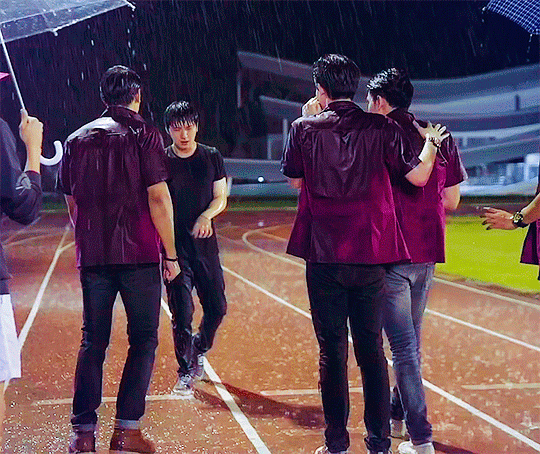
Rather than a critique of the SOTUS system itself, the system provides the organizational hub for the series' broader societal commentary, and itts treatment elevates the show to the likes of Friday Night Lights or Skam. Jane Austen's Pride & Prejudice title was taken from a line in Fanny Bruney's Cecilia about the two faults being both the cause of miseries and the reason for their termination. The series treats the SOTUS system and everything else within in the same manner: with complexity rather than binary keep-it-or-leave-it moralism. The S.O.T.U.S. values parallel the confines of a deeply imperfect society that when seen as strictly authoritarian pass down rules and pain from the elder generation to the the next. However, when viewed and practiced as the series encourages by the end of its story through a more nuanced understanding of the Asian filial philosophies at play, the values of seniority, order, tradition, unity, and spirit also invite compassion and affinity flowing in both directions across the generations.
The slowly emerging slight but significant age-gap romance between righteous freshman Kongpob and head 'hazer' Arthit is the central device for this exploration, but every element and scene, from the side couples to the food orders, develop our sense as viewers of the social order that the show wants to address. And the scenes move like well-lubricated assembly-line machinery toward their final purpose. It's obsession-inducing.
Despite the machinery of SOTUS's pacing, it delicately fashions its character and an environment gently permeated by homophobia and misogyny. Celebratory moments occurred to highlight themes without drawing attention to themselves, heterosexual coupling and marriages, for example, or a classmate coming out. Slurs surfaced casually, too, and old-fashioned masculinities were performed not as major plot points, spectacles of violence, or lessons for characters to immediately learn from, but to illustrate how inherited ignorance and constraints bear down almost invisibly on the characters. No one was demonized or ostracized for their ignorance, not because the writers view their actions positively but because they view their ignorance as a product of systematic failings, failings each generation can and will attempt to improve upon as they inherit the reigns. No one generation will make it all perfectly right. They are only human.

You can feel that humanity in the way the characters are written. All of the characters are distinguishable and interesting. They're written well and performed with heart. We have actual girls just chilling and being friends in a BL series, which was historically novel. Ingenues and horny girls and shy lesbians. The guys are recognizable guys, which is another feature Thai BL does exceptionally well. There are some dorks, some bros. The best friend in the freshman group is shy with strangers but open with his friends and fierce on the basketball court. I've known people like these. They are characters that are broad enough to recognize from a distance (or less screen time) but not simple stereotypes.
Then, on top of this you have the casual trans, gay, and nonbinary inclusion of bit parts and side characters that, to this day, only Thailand is doing in its shows to this extent. Its just impressive to see that their BL industry started off from the get-go at this level. But in SOTUS its not simply casual inclusion, either. These characters, unlike comparable characters in Love Sick, delineate moments of queer kindness that blur the understood hierarchical order of the initiation system and the heteronormative order holding our romantic leads back. In subtle ways they offer queer guidance and a model to Kong on his journey.

Then there's Kongpob and Arthit at the queer center of it all. Ugh! These two characters! These two performances! In Singto's watery sphynx-like eyes, in Krist's clinched jaw, in the electrified space between their bodies that the characters must restrain themselves against crossing, these are the heights of longing the romance genre can reach at its peak. There's an inner pain in these characters. That pain is old-school romance and its old-school queer pain.
I've read complaints about the physical intimacy in this show that I realize after watching the series are ignoring the characterizations of repression and inexperience that impact every interaction between Art and Kong, even their kisses. They aren't on the het timeline, instead having their first kiss and relationship in college, which is why SOTUS aligns with the teen drama genre so well despite its university setting. The greenness of their physical affection (we see it grow more competent and comfortable as the show progresses), however, belies an emotional chemistry that's intense, erotic, and intimate. Many more explicit BL scenes feel tame compared to Arthit grabbing Kong's shirt in rage or whispering in his ear in front of a waiting taxi.
I'm looking forward to SOTUS S and its Our Skyy episode to see more about KongArt's partnership, because their characters resist the seme/uke categorization of the BL genre they emerge from (which are also basically the stereotypes of top and bottom that gay men placed on themselves lol). Their ages and behaviors are reversed from the expected, first off. Kong, the younger, pursues, making him technically the seme and Arthit the uke, character definitions that also indicate sexual preferences of top and bottom. This wasn't unheard of in BL texts from what I've read, but less typical. Then there's the matter of Arthit being the one who initiates physical affection, partly due to Kong's regard for his challenges with internalized homophobia. Apparently, even the pronouns used between the pair are an intimate negotiation rather than an accepted order, returning us to the more complex ways the S.O.T.U.S. acronym can be enacted.
Plus, Kong's played by Singto with impressive power and confidence that's still soft-spoken, slippery, sibilant. To my trained eyes, its a character with mannerism and speech that are legibly gay. Not so legible that all his peers will notice, but he's clockable for queer eyes and worrisome for those afraid of deviation from the norm. For me, this is Thailand's biggest BL breakthrough (and its persisted down this path*) because, for many in the LGBT+ community, challenges begin well before anything to do with sexual attraction.

Gender deviance is the key issue. I was teased by a classmate at 8, well before I had a sexuality, that when I walk I move my hips like a f*gg*t. Don't worry. He wasn't totally wrong. I have a killer strut and I own it now. His antagonism wasn't about who I liked; it was my swish, my non-masculine behaviors. The hatred of gender deviance (and its misogynistic reasoning) is the underlying bogeyman for much of homophobia. Even plenty of men who are perfectly happy to have sex with men, at least where I live in the US, take issue with effeminacy. (Try finding the most overt lesbians on tv outside of OITNB, too!) That applies to audiovisual media, too. Unless comedic, consumers have tended to be more excited about queerness when the bodies and expressions appear in-line with gender expectations. The power of Thai BL and Singto's performance of Kong is how it opened space in the market and audience's minds to take queer affects seriously in young adult romance.
It's no surprise, then, that Kong forges friendships with the characters who are overtly LGBT during the series. The associations made between Kong and the fullness of the LGBT spectrum provides a more complex context for the show's choice to include him expressing the BL trope of 'only gay for you.' While it's a harmful concept broadly, the show seems to be using it subversively. How much more regressive it would've felt coming from Arthit! With Kong and all of his queer associations, it plays as the words of a gay romantic. With the diversity of coming-outs and identity-naming we now have in BL, Kong's moon-eyed statement made on the night his boyfriend comes out for him holds less of a harmful influence on the whole.
Context is just as important to the oft-critiqued scene where Kong says that he'll make Arthit his wife. Based on what I'd read and how impactful and problematic people felt it was, I thought the statement had been a romantic declaration late in the series. Imagine my surprise when it occurred in the first episode as an attempt by Kong to disrupt the patriarchal power of the seniors. Rather than illustrating the show's belief about gay relationships being the same as straight relationships, the scene points to the patriarchal assumptions the series intends by its end to disrupt. The exchange gets reenacted when the freshman decide to act it out at the faculty beach outing for everyone. The seniors interrupt, and the freshman fear they're about to be punished for disrespecting their elders only to find out they're being invited to finally celebrate their inclusion into the faculty. It's denied fruition as a tool to dis-empower and a true testament of Art and Kong's relationship.
It's at the beach where the freshman are given their gears, one of the many examples of how the series used symbols with significantly more depth than the copy-cats that tried to make bank by using the exact same motifs later. The proceeding BL engineers owe not a debt but an apology to SOTUS. The engineering faculty fit perfectly with the show's questions about systems and how individuals fit into them. We have these gears, which could simply be cogs in a machine that forces you to fit in and lose your humanity, but SOTUS envisions the gear as a heart, something unique, attempting to find its place and fit its grooves within a greater purpose. Its a symbol of authentic belonging.

The pink drink, which could've simply served--and has served in other series since--to be a symbol of pink gay girly tastes, is more fully used to emphasize Arthit's stubborn desire for familiarity, his inexperience (in trying other drinks), and a certain childishness in his preference for sweetness, a childishness that humanizes him to his freshman paramor. A trade even occurs with the drink, shifting all these meanings onto Kongpob as he begins to face his own prideful assumptions about his own righteousness.
Beyond all the English teacher symbolism and queer value, though, SOTUS is just the kind of well-told romance that will make you swoon. Despite a low budget and simple plot, its performances, editing, and most of all its script mesmerize. People shouldn't watch it as a history lesson. Its too entertaining to be relegated to that. Labeling it as simply historically important doesn't do it justice.
SOTUS stands tall among teen dramas, a literary work in a genre that doesn't require those heights; SOTUS stands tall among queer media peers, paving new lanes for queer storytelling and performances to walk down; and SOTUS stands tall among its BL peers. Clearly many of the greats in Thai BL, like 1000 Stars, Bad Buddy, and Until We Meet Again, aim to evoke their predecessor, more out of love and awe than an apology (as has been suggested by others). The ways they differ seem to be additions and diversification of queer narratives rather than a critique. SOTUS is simply one of those Great Stories. It inspires binging, revisits, investigations, and, most importantly, the biggest feels. Watch it now if you haven't. Watch it again if you have. Its not a piece of history. Its the kind of story that doesn't get old.
*Thank goodness for LITBC bringing Korea some overtly gay characters. Japan's got a few options--KENJI!--but not enough for my liking yet. I haven't seen enough of the other country's output to make a judgment.

Tagging @dropthedemiurge for being the biggest supporter of my new-found SOTUS obsession and @respectthepetty for the petty watch that got me over my lack of motivation to watch this series! Petty was half-joking but also so right about the kink undertones to this relationship!!!
There are certainly more versed BL history experts so feel free to let me know about any mistakes I made with my history! I'm just a broad and casual tv history and queer fiction and history fan tryna share my new-found BL joy.
#sotus#sotus the series#kongart#singto prachaya#kristsingto#krist perawat#took me a whole week to put this all together but it was so worth it#I love this series so much#Now i can finally let myself watch SOTUS S!!!!!
91 notes
·
View notes
Text
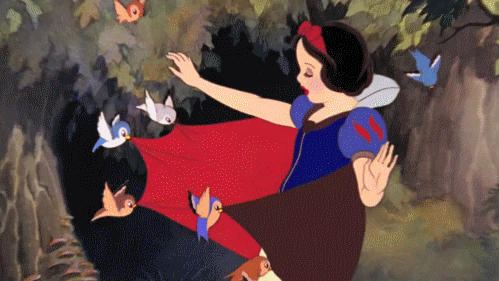
BEFORE YOU SEND AN ASK… 🦢✨
hi angels! ₊˚⊹♡ i LOVE answering the asks you send to my inbox, but a girl’s gotta lovingly set healthy boundaries 🥹 so here’s a “master post” of sorts regarding asks i will answer, asks i’ll delete/not prioritize, and so on! <3 i had this info listed on my directory post (pinned) as well, but i just wanted to give it it’s own post so it’s more clearly accessible!
. ★⋆. ࿐࿔ ✦ . . ˚ .ੈ✧̣̇˳·˖
🕊️⋆ˊˎ- “HOW ARE POSTS ANSWERING ASKS ORGANIZED?”
you can navigate through these posts by searching the following hashtags on my blog:
#askprincessmanifestation -> for anything reality shifting/law of assumption/manifestation related!
#askprincessgeneral -> for general chatting/other asks!
#askprincesssuccessstory -> for all the success stories you send through! i love celebrating with you!
. ★⋆. ࿐࿔ ✦ . . ˚ .ੈ✧̣̇˳·˖
🖋️⋆ˊˎ- “HOW CAN I BECOME ONE OF YOUR ANONS?”
if you’d like to easily find my posts answering your questions or don’t want to keep reintroducing yourself with every ask (but you still want to stay ANONYMOUS), please sign off your ask with an emoji or ask to be [EMOJI] anon! (ex. “can i be ☀️ anon?)
you can then just search “#[EMOJI] anon” on my blog, and you should find all related posts filed under there!
please refer to this 🔗 LINK to make sure the emoji you want to use hasn’t been taken yet to avoid confusion! <3
. ★⋆. ࿐࿔ ✦ . . ˚ .ੈ✧̣̇˳·˖
🥧 ⋆ˊˎ- GENERAL NOTES ABOUT ASKS
please go through my blogs before sending an ask! if i’ve already answered your question inna blog (ex. “can i manifest ___?”), your ask will take lower priority due to the high volume i get in my inbox! 🥹🫶 always here to help, but i’m only one girl!!
please refrain from sending the same question multiple times with the intention of urging a faster response! 🔗 LINK TO MORE IN DEPTH POST
. ★⋆. ࿐࿔ ✦ . . ˚ .ੈ✧̣̇˳·˖
💌⋆ˊˎ- EXAMPLES OF ASKS I’M HAPPY TO ANSWER (includes but not limited to):
⤷ thoughtful questions
⤷ help reframing circumstances in your favour/providing a different perspective on situations
⤷ clarification regarding my posts/concepts discussed
⤷ success stories
⤷ just general chatting! <3
💋⋆ˊˎ- ASKS I’LL LOVINGLY DELETE/NOT PRIORITIZE:
⤷ anything health-related and/or needing medical/therapy-level support
i care about you but this blog is not the place to seek medical-level aide! i strongly encourage you to reach out to trusted resources, whether that be local hospitals or online healthcare providers. <3
⤷ negative spirals/ranting/venting
i totally understand needing to let things out! as much as i want to hold space for all your feelings, i may not always have the capacity to answer asks like these. i’m just one girl with my own life and journey, and i intend to keep this space rooted in healing, positive energy, and empowerment. if you’re going through a hard time, please consider reaching out to a mental health professional. you deserve proper support and you don’t have to feel alone. <3
⤷ anything that doesn’t align with the energy of this blog — this is a place of empowerment, healing, growth, and positive, intentional manifesting only.
this includes but is not limited to: unethical hypotheticals, anything violent/harm related, and intentionally provoking/controversial asks! respectfully, i am not here to entertain disturbing scenarios (i strongly suggest you reach out to a licensed therapist, etc. if this is something bothering you). please keep asks aligned with this blog’s positive energy! 🔗 LINK TO MORE IN DEPTH POST
⤷ questions that can be answered via my blog posts or a quick google search
lovingly not prioritized so i can focus my energy on asks that can’t be answered as easily. i really encourage you to explore my page (the directory is there to help!) and do a bit of your own research too — shifting/law of assumption are such personal journeys. as much as i adore helping out, i’m also just one girl with her own life and her own path. thank you for understanding! <3
⤷ anything mean, judgy or anti-shifting/manifestation/loa
this space is rooted in love, curiosity, and empowerment, so i won’t prioritize asks that are judgmental, mean-spirited, or anti-shifting / manifestation / loa. i’m just one girl sharing her journey and thoughts. that being said, i don’t wish to spend my energy on skepticism, negativity, or closed-mindedness. respectfully, it’s a fruitless conversation if your intent is to “prove me wrong.” there’s a difference between being genuinely curious and projecting disbelief. you’re free to hold your own beliefs, but please don’t trample over mine just because they don’t resonate with you. <3
. ★⋆. ࿐࿔ ✦ . . ˚ .ੈ✧̣̇˳·˖
thank you for respecting my boundaries and helping me keep this space gentle, safe, and aligned. love you always, and i hope this blog continues to be a warm, empowering corner of the internet for us both. 🫶
love and light always <3
#askprincessgeneral#askprincesssuccessstory#askprincessmanifestation#law of assumption#loassblog#affirm and manifest 🫧 🎀✨ ִִֶָ ٠˟#loassumption#loa tumblr#affirm and persist#affirmations#how to manifest#living in the end#4d reality#law of assumption motivation#shifting motivation#shiftingrealities#shifting tips#shifting realities#shifting community#shiftblr#shifting blog#reality shifting#neville goddard#void state#lawofassumption#loa blog#loa advice#loablr#law of manifestation#loass
33 notes
·
View notes
Text

Deep in the Mediterranean, in search of quantum gravity
A study published in JCAP places new limits on quantum gravity using data from the underwater detector KM3NeT
Quantum gravity is the missing link between general relativity and quantum mechanics, the yet-to-be-discovered key to a unified theory capable of explaining both the infinitely large and the infinitely small. The solution to this puzzle might lie in the humble neutrino, an elementary particle with no electric charge and almost invisible, as it rarely interacts with matter, passing through everything on our planet without consequences.
For this very reason, neutrinos are difficult to detect. However, in rare cases, a neutrino can interact, for example, with water molecules at the bottom of the sea. The particles emitted in this interaction produce a “blue glow” known as Čerenkov radiation, detectable by instruments such as KM3NeT.
The KM3NeT (Kilometer Cube Neutrino Telescope) is a large underwater observatory designed to detect neutrinos through their interactions in water. It is divided into two detectors, one of which, ORCA (Oscillation Research with Cosmics in the Abyss), was used for this research. It is located off the coast of Toulon, France, at a depth of approximately 2,450 meters.
However, merely observing neutrinos is not enough to draw conclusions about the properties of quantum gravity—we must also look for signs of “decoherence”.
As they travel through space, neutrinos can “oscillate”, meaning they change identity—a phenomenon scientists refer to as flavor oscillations. Coherence is a fundamental property of these oscillations: a neutrino does not have a definite mass but exists as a quantum superposition of three different mass states. Coherence keeps this superposition well-defined, allowing the oscillations to occur regularly and predictably. However, quantum gravity effects could attenuate or even suppress these oscillations, a phenomenon known as “decoherence”.
“There are several theories of quantum gravity which somehow predict this effect because they say that the neutrino is not an isolated system. It can interact with the environment,” explains Nadja Lessing, a physicist at the Instituto de Física Corpuscular of the University of Valencia and corresponding author of this study, which includes contributions from hundreds of researchers worldwide.
“From the experimental point of view, we know the signal of this would be seeing neutrino oscillations suppressed.” This would happen because, during its journey to us—or more precisely, to the KM3NeT sensors at the bottom of the Mediterranean—the neutrino could interact with the environment in a way that alters or suppresses its oscillations.
However, in Lessing and colleagues’ study, the neutrinos analyzed by the KM3NeT/ORCA underwater detector showed no signs of decoherence, a result that provides valuable insights.
“This,” explains Nadja Lessing, “means that if quantum gravity alters neutrino oscillations, it does so with an intensity below the current sensitivity limits.” The study has established upper limits on the strength of this effect, which are now more stringent than those set by previous atmospheric neutrino experiments. It also provides indications for future research directions.
“Finding neutrino decoherence would be a big thing,” says Lessing. So far, no direct evidence of quantum gravity has ever been observed, which is why neutrino experiments are attracting increasing attention. “There has been a growing interest in this topic. People researching quantum gravity are just very interested in this because you probably couldn’t explain decoherence with something else.”
IMAGE: The visualisation of a simulated event in the KM3NeT/ORCA detector. Credit CC BY-NC 4.0 https://creativecommons.org/licences/by-nc/4.0 Credits KM3NeT
9 notes
·
View notes
Text
Hello Darlings 🌻
So I received a Nonny message asking for clarification regarding Zelda’s situation in yesterday’s post. While I am always glad to answer Nonny messages, please keep in mind that I do not have the ability to answer those asks privately as I would if you sent them off anon. While I totally understand why y’all use anon, it does limit my ability to address them, especially for more sensitive or personal questions.
However, I still wanted to resolve this question as yesterday’s post comes from a very personal place, and perhaps for that reason, I do want it to be clear moving forward. While I think subsequent posts may do that, in case they do not, I will also answer it here.
That said, I will be doing so under the cut because it involves a more in depth discussion of Zelda’s situation in yesterday’s post. So if that post is as far as you would like to go on this subject, please stop reading here.
No, Zelda did not have a miscarriage. Nor did she just “not become pregnant.” Zelda and Antoine have more or less been trying to get pregnant for a year, and she has continued to get her period month after month. Let me make something abundantly clear, I am in no way minimizing the pain of having a miscarriage, nor ignoring how that could have been the conclusion of that post. However, I am specifically writing about a different experience with one’s fertility and how that can affect one’s mind in its own way.
I am clarifying this because it is its own, albeit deeply related and sometimes simultaneously experienced, pain. That is because many people will view it as “you never had anything to lose” or “there was never any traumatic event to be upset over.” It is a slower pain, damn near constant; that comes to you in cycles as you follow your own so closely.
As many women who have tried to get pregnant can testify, the hyper awareness of one’s fertility can be overpowering, as you restart each and every month, planning your life around the best time to try and conceive. Then once that passes, you search your body for every little sign to tell you whether or not you succeeded. But still, there’s nothing you can do but wait.
There’s a very specific line in that post that sometimes Zelda was late enough to make them think she had conceived. Imagine there is no pregnancy test, and all you can do is hope that every time you look down, you haven’t started your period. Even if it’s “just” one day, or a few hours, you do it every single time. Every single trip to the bathroom becomes a high stakes moment because if it’s there, then you “failed”, and you have to start all over again. Until sooner or later it eats away at the excitement and hope you felt when you first began the process.
It is exhausting and Zelda’s statement that “she is broken” becomes an almost inevitable thought as it happens over and over and over again. Meanwhile there seem to be countless examples or even other women telling you that it should be easy or that all you have to do is relax. Even worse, you’re told you have to “keep trying” because nothing “bad” has happened, has it?
There are countless women in this position, and if you are or have ever been one of them, my heart goes out to you. That is why I wanted to clarify this before we proceed any further in this story, because this is a very intentional experience I am writing about and I don’t want it to be misinterpreted for that very reason.
64 notes
·
View notes
Text
Revisiting the Rat Cook, Part 1: The Best Pie, and Lord Lamprey
This is the first part of a series I've been sitting on for a while, where I'm going to examine the symbols and themes present in the "Rat Cook" story, as relayed by Bran in ASOS Bran IV, and search reappearances of those elements throughout the rest of ASOIAF.
This series is predicated on the understanding that these books are rich with intentional symbolism, metaphor, and allegory, and that the repetition of these symbols and themes adds to their meaning.
In general, the symbols that are present in ASOIAF are limited by their ability to be inserted into the plot of the story (i.e. if the symbol of a stag killing a direwolf is important, there must be a way in which the characters are able to encounter such a scene within the plot's context). However, the metadiegetic legends that exist in-world for the characters of ASOIAF are not beholden to the same restrictions, and because GRRM is able to invent these myths in their entirety without restrictions on any of the individual symbolic elements, we can trust that each separate element of these in-world myths was placed intentionally.
With that in mind, I believe we can use stories like that of the Rat Cook as a sort of "road map" when looking at the reappearance of these same symbols and themes elsewhere in the story; I believe the "Rat Cook" story is the most distilled example of these elements. I don't mean to say that every instance of "rats" references the Rat Cook directly, but that the Rat Cook story provides a place where Martin is able to use these symbols in their most abstract form and describe their relationship to each other, so that when we see them appear again elsewhere in ASOIAF we might better understand what we are being shown.
So, among other things, the Rat Cook story is about a rat which eats rats, or a cook who serves kings; The Rat Cook story is about fathers and sons, about cannibalism, about trust, about vengeance, and about damning one's legacy.
This is likely going to be a 9-part series, but ideally almost all of these parts will be able to stand on their own. Each post will inform the next as I build my analysis, but hopefully each individual post is also interesting in its own right.
RtRC Part 1: "The Best Pie You Have Ever Tasted" and "Lord Lamprey"
This opening part, for better or worse, is going to retread some well-discussed ground: the clear parallels between the "Rat Cook" story and the incident in which Lord Manderly serves certain overlarge pies in ADWD The Prince of Winterfell, a scene lovingly dubbed "Frey Pie". However, as well-established as this comparison is, I want to begin here so I can begin to introduce how a closer analysis of the Rat Cook themes are present in this uncontroversially parallel scene, and how they might add more depth to interpreting that moment.
Not only does the scene evoke the same imagery, serving pie to the Lords amidst conspicuously missing sons, but the connection becomes even more direct when Wyman Manderly looks directly to the camera and says, “Hey reader, if you’re wondering where those Freys are, think back to any scary stories you know about pie”.
Okay, he doesn’t actually say that, but it’s close enough, and as much of a nudge we’re like to get from Martin (and which still went over my head on my first read through). Instead he does the next best thing, cueing Abel to sing while staggering past our POV:
"We should have a song about the Rat Cook," he was muttering, as he staggered past Theon, leaning on his knights. "Singer, give us a song about the Rat Cook."
Manderly seems to acknowledge the similarities himself, and most have noticed as well.
However, making the comparison between the story of the Rat Cook and Manderly’s actions is particularly interesting in their differences.
There are many ways in which Manderly’s pies, as a mirror, are appropriately an inversion of certain elements in the Rat Cook myth.
Returning to the scene as we see it in ADWD The Prince of Winterfell:
“Ramsay hacked off slices with his falchion and Wyman Manderly himself served, presenting the first steaming portions to Roose Bolton and his fat Frey wife, the next to Ser Hosteen and Ser Aenys, the sons of Walder Frey. "The best pie you have ever tasted, my lords," the fat lord declared. "Wash it down with Arbor gold and savor every bite. I know I shall." “True to his word, Manderly devoured six portions, two from each of the three pies, smacking his lips and slapping his belly and stuffing himself until the front of his tunic was half-brown with gravy stains and his beard was flecked with crumbs of crust.”
Manderly takes on only some of the roles of the Rat Cook here. Despite his status as lord, he plays the role of the humble cook, personally serving Roose Bolton, Walda Bolton (née Frey), Hosteen Frey, and Aenys Frey, all standing in for the “Andal King”. In this way, the role of “Andal King” as someone who has official power and the role of “Rat Cook” as effectively powerless dissident are played out straightforwardly. Bolton and his allies are backed by their army and the authority of the crown while Manderly has no official backing of his own.
Wyman even physically resembles the Rat Cook; Wyman’s blue eyes indicate he is presumably pale, and Wyman is prodigiously large, to mimic the descriptor of “white, and almost as huge as a sow”.
However, like the “Andal King” himself, who had a “second slice” of his own son, it is Wyman Manderly, and not Bolton nor the Freys, who devours two portions from each of the pies. In this way, the roles have elements which are interchangeable.
Wyman is acting out both roles, which is especially interesting because in this comparison is a single most definitive contrast: The Rat Cook, most notably, is not punished for serving the pie, as "a man has a right to vengeance". Instead, he is punished for violating guest right.
Now, Wyman—who lost his son to the Freys at the Red Wedding—certainly has a “right to vengeance”, but betraying guest right is something which Wyman Manderly takes great pains not to do. Manderly conspicuously notes that he gave the three dead Freys guest gifts upon their parting, marking them as no longer guests under his roof, and subsequently, theoretically, freeing him to kill them. Manderly introduces the idea while Davos marks the distinction for the reader’s sake in ADWD Davos IV:
“The Freys came here by sea. They have no horses with them, so I shall present each of them with a palfrey as a guest gift. Do hosts still give guest gifts in the south?" "Some do, my lord. On the day their guest departs.”
The Freys, on the other hand, as executors of the Red Wedding, are the most notable violators of guest right, while the Boltons contributed their part as well; both are being punished for that sin by Manderly-the-Rat-Cook here, marking the inversion of the story. In this iteration, the party serving the pie seems to warrant no judgment; instead, the pie itself is the judgment, served as retribution. With that connection in mind, it's worth remembering the other importance of the Rat Cook story, based on its placement in ASOS and which I think has often been overshadowed by Manderly’s “Frey Pies” incident.
In the Rat Cook story, after the Rat Cook's punishment, he spends an immortal future forever eating his own descendants, a scenario in which Bran describes the rats of the Nightfort as “children running from their father”. That eternal, kin- and legacy- devouring doom does not just come secondary to the punishment, it is a part of the punishment following the violation of guest right, and introduces the notion of an entire family being cursed for that violation... and, for good measure, is brought up in ASOS Bran IV, chapter that occurs only a few chapters after the Red Wedding itself.
In one respect, this is just another reinforcement for the reader of the sanctity of guest right and of the laws of the old gods. Coming so soon after the Red Wedding, the Rat Cook story hints at the fall of House Frey. Walder Frey, most culpable violator of guest right, has apparently doomed the rest of his dynasty to death, punished for his actions, the way that the Rat Cook, too, is a patriarch who creates not only his own ruin but also the ruin of his progeny. Although Walder himself is not literally tying the nooses, it is Walder who has metaphorically become the father "devouring his children" indirectly through his ruthlessness. Wyman Manderly, then, is merely an agent of that doom.
On the subject of the Freys being cursed by violating guest right, only one of the named consumers of the pie, Aenys Frey, is truly mirroring the Rat Cook legend by literally eating his own son, Rhaegar Frey. Both Aenys and Hosteen Frey, on the other hand, are specifically called out in the scene as being the “sons of Walder Frey”. It’s appropriate within the mirrored Rat Cook motif to invoke Walder’s name as patriarch as well as the promise of other “sons” that might succumb to their father’s insatiable appetite for status; this sentence invokes the dynasty of the Frey household. Indeed, Walder Frey himself also has shared motifs with the Rat Cook: like the immortal Rat Cook, Walder Frey has nearly innumerable children and grandchildren, and he too seems to refuse to die.
If a named heir in Westeros is like the ASOIAF version of Chekov’s gun, then the Late Walder Frey is sitting on Chekov’s arsenal; once he becomes the late Late Lord Frey, it’s going to explode. If that happens in an upcoming book, then the Rat Cook story might be setting up the idea of how an eventual succession crisis of House Frey might further this metaphorical connection, with this doomed family turning on itself, each running from the shadow of their father’s legacy like the Rat Cook's children run from him in the Nightfort.
Lord Lamprey
Now, to push through a little more symbolic linking between the Frey Pie scene and Lord Manderly:
If we consider the “pie” element as a key part of the Rat Cook story, then seeing a “pie” specifically in the hands of Wyman Manderly prompts a connection with a noted favorite of Manderly’s: lamprey pie. As early as ACOK Bran II, we learn that:
“His own people mock him as Lord Lamprey”,
Interestingly, we see in that same chapter a telling metaphor considering Manderly and lampreys not in a pie:
“Lord Wyman attacked a steaming plate of lampreys as if they were an enemy host”.
Considering Wyman’s lampreys-as-enemy association makes for curious contrast later, in ADWD Davos IV, as Manderly is feigning allegiance with the hated Freys. Here, Manderly has just stepped away from the feast in order to secretly treat with Davos, and the food served may contain more meaning than at first appears:
“In the Merman's Court they are eating lamprey pie and venison with roasted chestnuts. Wynafryd is dancing with the Frey she is to marry. The other Freys are raising cups of wine to toast our friendship.”
The reappearance of this noted lamprey pie might take on more significance knowing that some of those eating it become a pie later on. The reminder of the association between Manderly and his lamprey pies seems even more intentional when the “Lord Lamprey” nickname conspicuously returns as Bolton’s men search for the missing Freys in ADWD Reek III:
"You did not find our missing Freys." The way Roose Bolton said it, it was more a statement than a question. "We rode back to where Lord Lamprey claims they parted ways, but the girls could not find a trail."
Invoking his nickname in this scene draws a connecting line between Manderly’s favorite pie, the “enemy host” of lampreys, the missing Freys, and “lamprey pie” being served as a symbol of the fake “friendship” between the Freys and Manderlys.
If that Frey-Manderly friendship is marked by mentions of lamprey pie, and Manderly loves to eat lamprey like he would eat an enemy, and we see in The Prince of Winterfell that Manderly apparently loves to eat his enemies, having two portions of each Frey pie, we might think that the Freys are being paralleled with Manderly’s favorite pie filling: lampreys. If that is the case, then comparing the punished Freys to lampreys is a scathingly fitting image, and I mean that literally.
Considering that carnivorous lampreys latch onto fishes to slowly eat the fish’s blood and flesh while the fish still swims, then looking at an image like this makes for some serious symbolic resonance if you consider the Tullys as fish (as they often are described) and the pie-filling Freys as pie-filling lampreys. It certainly provides a strong visual metaphor for the Frey’s “late” and half-hearted vassalage to Hoster Tully, how they dealt with Catelyn, and how they are now parasitically using Edmure—he sits in Riverrun at the end of ADWD, but with Freys latched onto him, bleeding him like they did his family.
This series is otherwise about pies and rats, not lampreys, but I will mention a few other interesting associations with lampreys that are worth looking into. The Stokeworths, when they are desperately trying to secure a match for Lollys, serve each of their prospective suitors lamprey pie, perhaps a signaling of the Stokeworth’s parasitic place at court, or the attitude towards their search for their daughter’s match. Note that in that context, Littlefinger remarks that he loves lamprey pie, perhaps fittingly for someone who has risen high by making use of his parasitic attachments to those more powerful. By contrast, when our intrepid advocate for truth and justice—Davos—is jailed after his return from the Battle of the Blackwater, he is served lamprey pie in the dungeons, but finds it “too rich” to eat. We have already seen that Davos has no stomach for the blind flattery that some of Stannis’ other lords have, and this scene describes that same character trait. I believe there are even further associations that are worth investigating, but for the sake of this essay, we must move on and end here for now.
In the next part, I'll focus on how it's relevant that the Rat Cook's pie and Manderly's pie were both allegedly "pork" pies, and where that reappears as well.
#asoiaf#a song of ice and fire#rat cook#asoiaf theories#literature analysis#wyman manderly#walder frey#RtRC
82 notes
·
View notes
Note
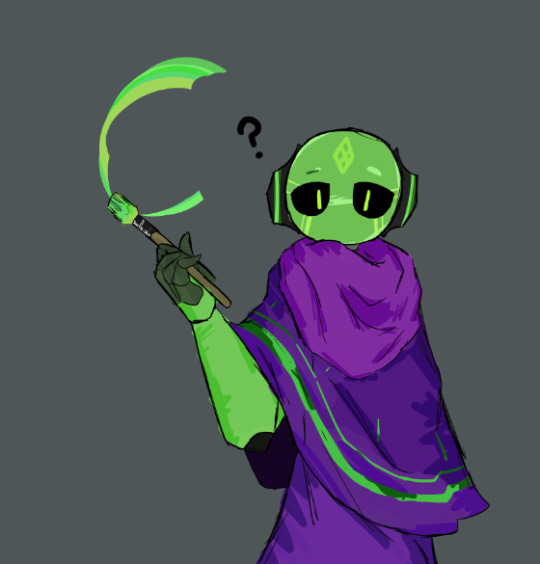
Woe, fan art be upon ye!
In all seriousness, I made this drawing to say and ask:
Your art is amazing, I aspire to become an artist like you!!!
A few questions... How do you usually shade and light? And what's the best way possible to draw backgrounds effectively? I hope you don't mind these questions!
On another note... I hope you have a good day
AAAAAAAAA THIS LOOKS AMAZING <3333 THANK YOU SO MUCH!!!! This means so much to me THANK YOU 😭💕💕💕💕 you'll achieve that dream someday!! so keep up the good work!! and never stop the grinding 💪💪 ! as for how i usually render..i'm not the best when it comes to explaining things but i'll try to! when i do shading i usually just mix and play around with the colors! blending them is super fun to do
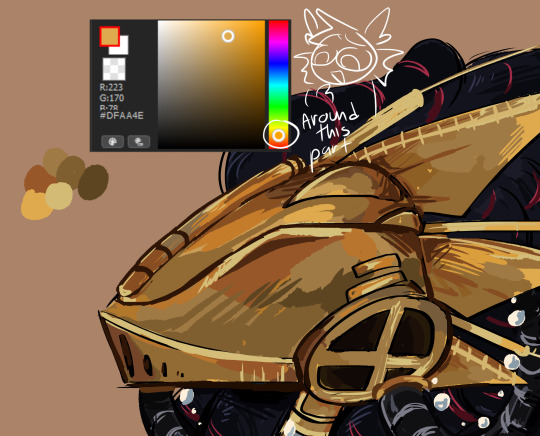
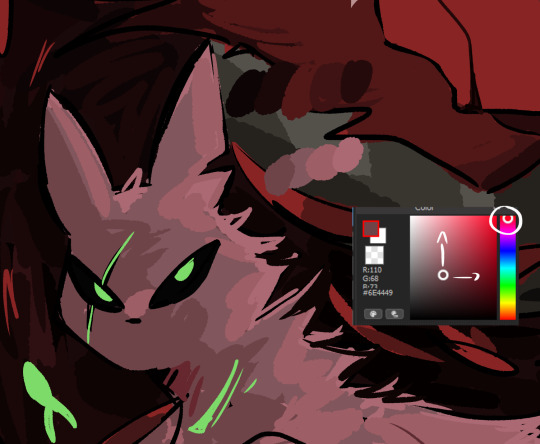
i like to experiment around with the color wheel and not limiting myself with just one color! i tend to use different colors to make them pop out more
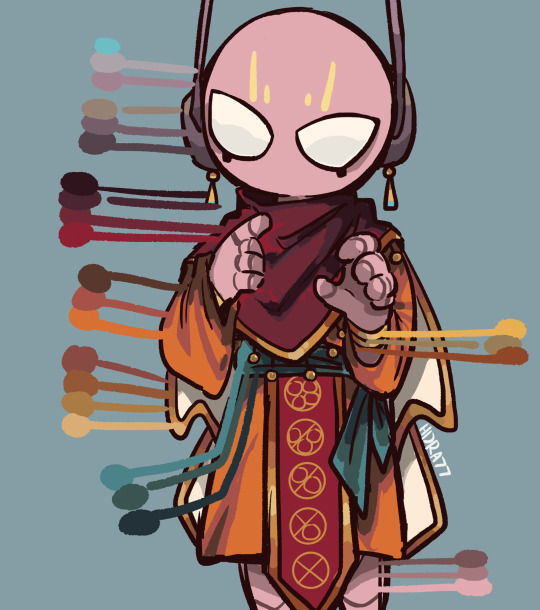
this also adds more depth into my pieces! notice how similar but different the colors looked yet they all appear to compliment well with each other? that also applies to lighting! i mostly just winged them and do whatever that feels right
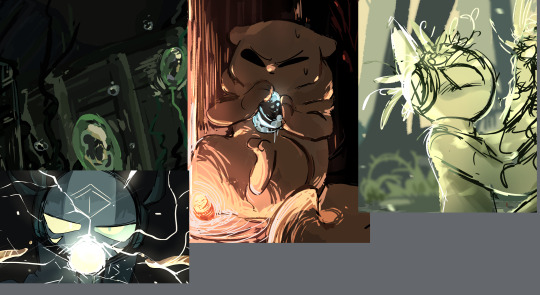
i think its already common knowledge about studying the light sources so i don't need to dwell into that! theres plenty of tutorials out there explaining better than i do and as you can see i tend to just..scribble around and call it a day
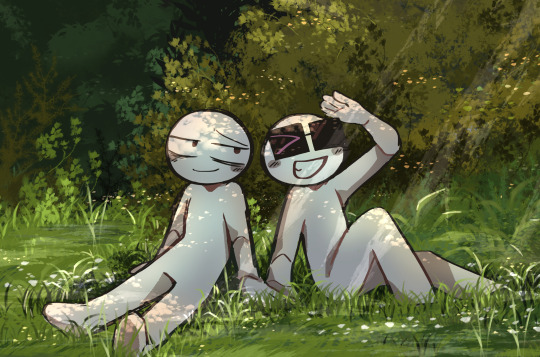
this ones one of my best example in lighting! light affects the surroundings so they have these soft little 'glow' on them it's all about the details really now as for the backgrounds: values and composition! darker colors + light colors add some depth!
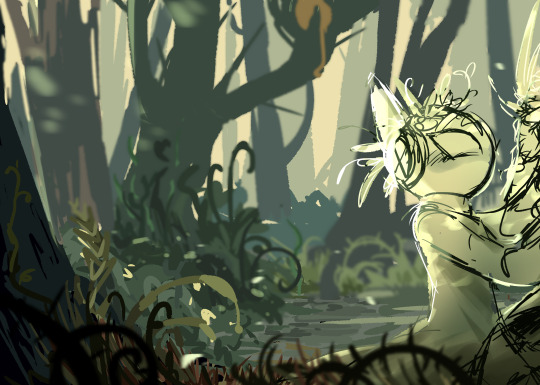
you'll notice how the choice of value affects the depth in this one!
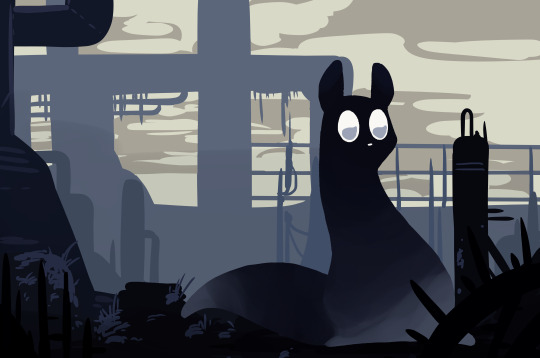
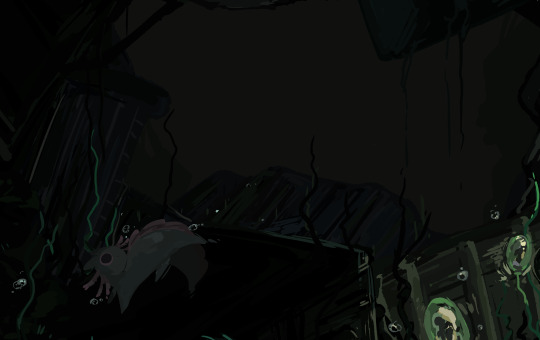
im not exactly sure how to explain the compositions that well but if you study how i draw you'll notice how a composition can change the mood of the environment!
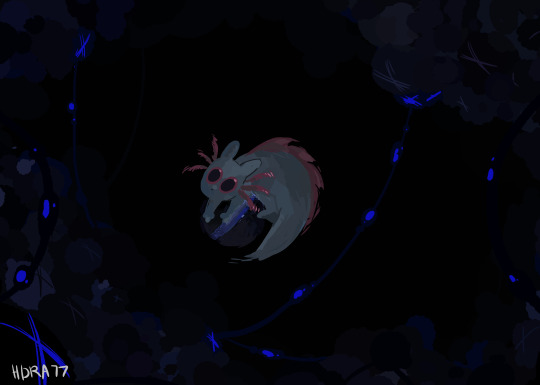
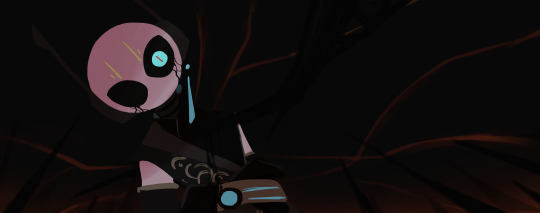
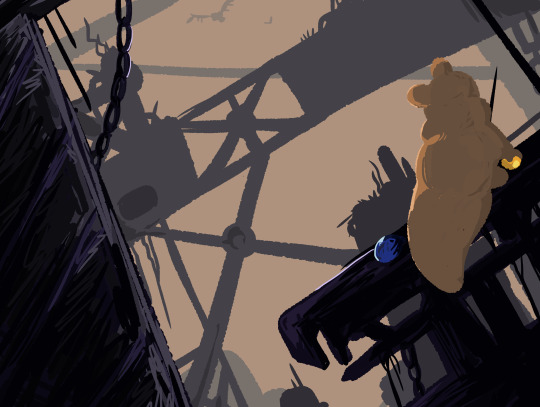
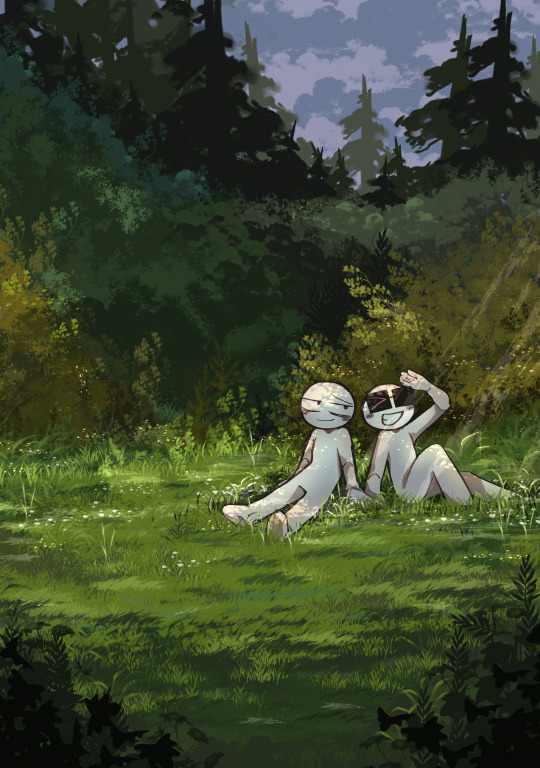
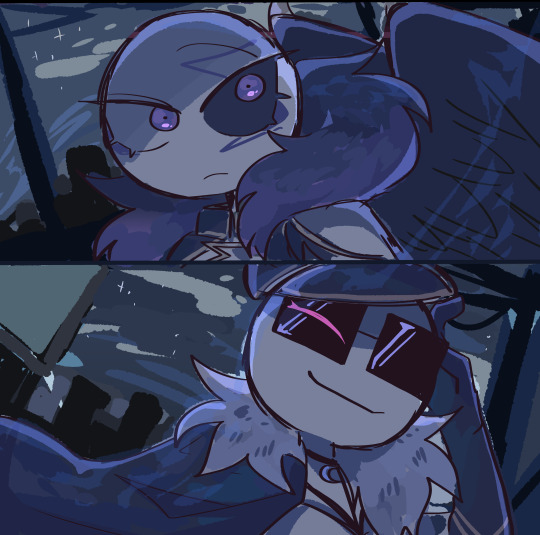
i hope this explains everything! i'm really bad with explaining how i do art but if you need more references just search more about color theories, values,symmetry and composition!
#asks#long post#if you have any questions or are confused on something please let me know!!#ill try to explain them as much as i could#fishdoestutorials#????
51 notes
·
View notes
Text
This is a compilation of the Transformers au, Tiny, Human, and mer, taking the opportunity to translate them into English, and gathering all the lore I invented along with what people apparently invent, since for example with mer they only include sex between fish and octopus Xd.
Tinyformers
Well, it starts with the typical Primus creation of the 13 Primes. The Cybertronian society is formed. They had to fight the Quintessons, who would make them smaller to reduce them and create different versions such as IDW, G1, Animated, Prime, etc., but the now Tinyformers defeated them. They became an invasive species motivated by Nova Prime, and even after his overthrow, they fought until the Decepticons, Autobots, and other factions were formed in order to achieve a certain peace. True peace could be achieved when they arrive on Earth while they were in another fight. Humans analyze them and decide to form an alliance. Humans would help them with resources and such, while the Tinyformers were like guardians, that is, they would be like Pokémon, so people could adopt them.
Humanformers
Cybertronians are a race of techno-organics, human-like but with the sizes we know from Transformers, and their bones are a metallic structure. They all wear armor but can also wear clothes. They are asexual or non-binary, or whatever you want to call it, but they don't have the concept of gender or ears.
They possess special abilities such as transforming body parts into weapons or tools. They are not capable of transforming into vehicles, but they can have the same capabilities. Their history and culture remain the same, but instead of being robots transforming into cars, they are humans with semi-robotics and car-like abilities. While humans are robots, albeit small and with limited capabilities, a symbiotic relationship develops with the Cybertronians. The Quintessons are organic humanoid octopuses, but they possess great cyberpunk-style technology.
Merformers
Everything goes back to what we could even consider a great city made of reef and metal, but it was all built by very special merfolk, unlike any known. It is even said that they possessed something mystical as their relics, but then they died, leaving their dynasty, creating a race called Merformers. They had their own home away from the outside world, other creatures, and especially humans.
But a fight began on the metal reef between the merfolk, mermaids, and other species. It is said that it was a war to see what methods of survival they should have, and they couldn't prevent this conflict from destroying their home, forcing them to leave for the first time to another place, having to experience the outside world and especially humans.
Although most people know the story, some theorize that they don't come from this planet, being aliens from a planet called Cybertron, and the real war took place there and not in the depths of the reef and ocean, forcing them to go to Earth in search of a home. However, there is really no evidence of this, and they are only theoretical to the point of paranoia. Now the Merformers will have to figure out how to deal with humans and a new environment completely different from their city.
#transformers#transformers au#tf au#humanformers#transformers human au#transformers humanization#human au#merformers#tinyformers#tiny
10 notes
·
View notes
Text
The Art of Manifestation 101
A guide that will change your life.

Understanding the Basics of Manifestation
1. Clarity Is Key
To manifest effectively, you must be clear about what you want. Vague desires lead to vague results. Take the time to define your goals precisely. Ask yourself: What do I want to manifest? Why do I want it? How will it positively impact my life?
2. Affirmations
Affirmations are positive statements that reinforce your desired outcome. When used correctly, they can reprogram your subconscious mind to align with your goals. Create a list of affirmations related to your desires and repeat them regularly. Don't think "oh I'm manifesting my dream body". Instead simply say your affirmations like a reminder, for example: "all my dream clothes fit me perfectly because I have the perfect body type for them".
If you struggle with what to affirm like me I like to go on Pinterest and search "__ affirmations". Read some and choose one or two that resonate with you.
3. Visualization
Visualization is a potent manifestation technique. Close your eyes, imagine your desired outcome in vivid detail, and immerse yourself in that mental image. Visualization helps you cultivate the feeling of having already achieved your goal. It's important to not just imagine it but really feel it instead. Manifesting money? See it, touch it, smell it and feel the happiness fill your body.
4. Release Doubt and Limiting Beliefs
Doubt and limiting beliefs can block the manifestation process. Recognize and challenge these negative thoughts. Replace them with affirmations that empower you and support your desires. Self concept affirmations are really helpful, here are a few suggestions:
"I am limitless"
"I don't chase, I attract. What belongs to me will simply find me"
"I deserve the life I want"
"I am ready to receive blessings"

The Manifestation Process
1. Set Your Intention
Start by setting a clear intention. State what you want to manifest, and be specific. Write it down and keep it visible to remind yourself daily.
2. Raise Your Vibration
Your vibrational frequency plays a significant role in the manifestation process. Engage in activities that raise your vibration, such as practicing gratitude, meditation, or things that bring you joy. Activities that allow you to connect to your body (such as dancing) or calming (painting etc.) can also be great for increasing your vibrations.
3. Detach from the Outcome
Manifesting often requires letting go of the need to control every detail. Trust the universe to bring your desires to you in the best possible way and at the right time. If you won't believe that the universe can do it then it won't.
4. Take Inspired Action
While manifestation is a powerful tool, it doesn't mean you can sit back and do nothing. Take inspired actions that align with your desires. These actions help bridge the gap between the spiritual and physical realms.
5. Be Patient and Persistent
Manifestation doesn't always happen overnight. It's essential to be patient and persistent. Maintain your focus and continue to believe in the process even when you encounter setbacks.
I would love to go into details so if you'd like to see a more in-depth explanation please like this post 🩷🩷

#dream girl#dream life#it girl#it girl energy#law of manifestation#it girl aesthetic#law of assumption#law of attraction#loa#loassblog#loa community#loassumption#loa blog#law of the universe#money manifestation#manifesting#manifest#manifestation#desired reality#desired person#dream girl journey#desired self#desired life#how to manifest#manifesting instantly#master manifestor#shiftblr#shifting realities#shifting#reality shift
91 notes
·
View notes
Text
Caregiver!Fabian Seacaster
Like all the other bad kids, he is not a permanent caregiver but insteads babysits. I do not think he caregives often but he often fulfils an older brother role or the kind of babysitter you call last minute.
Contains VERY minor spoilers for Junior Year in the third bullet point.
Fabian would be pretty alien to the idea of regression and caregiving at first. Regressing comes more naturally to him, and I think he struggles to know how to respond sometimes to regressors, especially if they're upset.
Not really a feelings focused caregiver, I think he picks that up from his dad where he expresses love a lot but still doesn't really talk about things in depth.
Fabian, as established in Junior year, is not a great cook. He would absolutely give his regressor takeaway all the time and go searching in the house for any kind of sweet treats. Anything he can find and doesn't have to cook is on the menu.
Not huge on physical affection but will hold his regressor's hand when they're walking someone or crossing the road.
Gets his old stuffed animals from a little box under his bed for his regressor to play with.
He will play wrestle or sometimes do imaginative games (he loves playing pirates).
Constantly looking up stuff on the computer because he is confused at first but really wants to understand. (He ends up knowing the most about it and doing the most research). While the other bad kids may have asked adults about it, Fabian tries to handle it all himself.
Fabian hums songs Cathilda sang to him when he cried as a child in order to soothe his regressors.
He would take his regressors out to the park and loves to play with them on jungle gym equipment.
Caregiving heals a very specific wound inside of him that he will definitely be exploring later in his life.
Wraps up his regressors in his battle sheet and twirls them around or wraps them up in a little blanket burrito.
Loves moving and staying active, he'll dance, he'll put on music. He makes sure him and his regressors stay active and enjoy movement. If Fabian had a disabled regressor who had limited movement, he'd look up ways to do different kinds of dances. For example, he'd look up some seated dancing choreography that him and his regressor could do together.
Stimboard here. Thank you for reading. :)
#gilear headcanons#caregiver!fabian seacaster#fabian seacaster#fabian fantasy high#fantasy high agere#d20 agere#fandom agere#agere headcanons#agere community#sfw caregiver#agere caregiver#sfw agere#sfw age regression
5 notes
·
View notes
Note
Hello! I have seen you mention your tabletop world multiple times (which sounds like it would be a blast to play in), and I was wondering if you would be willing to share some resources you drew on, or advice on deity portrayals? Im planning on running a game world with a focus on multiple real world religions and want to give them the respect deserved and look into how people worship them in the modern day, and while google searches help, I felt one of their worshippers would provide better answers.
Thank you in advance and I hope this message found you well.
Sorry for the late response. I wanted to wait until I had a proper amount of time to give an in depth answer.
Advice on recourses:
So first off, I don't have a doc of resources or anything. But I can tell you a bit about finding your own places for inspiration.
When worldbuilding the biggest advice I can give is to not just look at the same genre of setting you worldbuild in for inspiration. Look at the real world, real science, real history, real folklore, etc. And when you're looking for inspiration from fiction, don't limit yourself to that genre your looking at. Creative inbreeding is a major problem, where you only take inspiration from things similar to what you're doing, so everything looks kind of the same, this is why a lot of high fantasy settings end up looking weird and the same, because everything they're taking inspiration from is another high fantasy setting.
Using my own worldbuilding as an example of how to avoid creative inbreeding: my superhero setting as it's core premise comes from placing abhramic folklore around angels and demons into the context of a superhero setting. So when starting out instead of just looking at other similar settings for inspiration, I was looking at a mythology that rarely gets adapted into that type of setting. There's a lot more that's gone into my setting since that original premise, but everything feels a lot more unique and original because of that even when it's playing on tropes.
Look at things from various sources and think about how they'd fit into your world. And importantly, when incorporating something don't just take it as is, think about all the interactions it might have with other aspects of your world, and be willing to change it as you will to fit it into what you have.
I go to meusums a lot, and every time I come home from one I get a lot of ideas from them. Fossils give me ideas for creature designs, art can be me ideas for cultures and locations, etc. I don't know what your equivalent to that is, you might not even know that yet, but I'm sure it's something.
If you want to know more about my worlds specifically:
I realize this might be what you meant by sources. If so, I don't want to give much publicly, but you can dm me about them. I have four settings I work with regularly, a scifi setting, a post apocalyptic setting, and urban fantasy setting, and a superhero setting. For publicly available things from those on my blog, there's a short story in my post apocalyptic setting called forest of the damned, and almost all my art is from the other three settings. Back in 2023 I posted about a campaign I had in my urban fantasy setting, but after that campaign ended, and we moved to a campaign in my scifi setting, I became more private about it for various reasons. As I said, you and other close followers can DM me, but please respect my privacy and the fact that I do want to use all of this in future bigger projects.
On religion:
My advice for portraying any real world deities is to look up videos or posts by their followers discussing experiences. I'd be willing to tell you about the specific experiences I've had with the gods I worship, but note that I've only had experiences with a handful of gods (and that's also something I might rather have in DMs).
Hope that helped.
#196#worldbuilding#worldbuilding advice#creative writing#writers#writer#writing#writers on tumblr#writeblr#writers and poets
3 notes
·
View notes
Text
Tomba! Special Edition launches August 1 for PS5, Switch, and PC, later for PS4
From Gematsu
*There's a few short videos on the site I can't copy/paste on here

Tomba! Special Edition will launch for PlayStation 5, Switch, and PC via Steam on August 1, followed by PlayStation 4 at a later date, developer Limited Run Games announced.
Here is an overview of the game, via Limited Run Games:
About
Tomba! returns in Tomba! Special Edition, the ultimate version of the legendary platforming masterpiece. As the titular Tomba, you leap, bite, and throw your way across stunning 2.5D landscapes on a quest to overcome a deplorable cadre of nefarious pigs. Along the way, you’ll explore ancient relics, discover fascinating characters, unlock thrilling quests, and unearth hidden treasures. It’s a platforming adventure that perfectly fuses linear and nonlinear gameplay styles. Tomba! was first published in 1997, and is back today in a vastly-expanded special edition packed with quality of life improvements.
Key Features
Save Anywhere! No more worrying about heading back to a checkpoint.
Rewind! Stuck on a difficult challenge? Try again!
Toggle for analog control
A museum crammed with classic print advertisements, original packaging and manuals, never- before-seen dev documents, and high-res original artwork.
A new remastered soundtrack.
Interview with the creator, Tokuro Fujiwara.
And here is a new interview with Tomba! creator Tokuro Fujiwara published on PlayStation Blog:
In 1997, when you made Tomba!, most developers focused on making 3D games like Tomb Raider or Crash Bandicoot. You instead decided to mix 2D sprites with perspective-shifting 3D environments. Why? Tokuro Fujiwara: “Tomba! runs on 3D technology, with gameplay designed around 2D principles. This is why it’s described as a 2.5D game. I think 2D games have a certain kind of charm that 3D doesn’t. I also wanted to push the limits of what could be done. To bring my vision to life, I needed to use 2D principles along with 3D CG visuals. This allowed me to create something that felt new on the PlayStation. “There were times when I wondered if I should go 3D instead, 3D games have a very clear sense of space. In 2D, all the action takes place on a flat plane, and multiple layers provide a sense of depth. This means you have to design the game in creative ways so that the different layers don’t conflict. This results in something interesting that can only be achieved with 2D.” What do you hope new players will take away from Tomba! Special Edition? Fujiwara: “Tomba! has many side quests. These come in different varieties and are hidden throughout the game. I encourage players to seek them out. Various items allow players to learn new moves, expanding how levels can be beaten. I hope players search and seal away the Evil Pigs scattered throughout the world, which will unlock even more to see! There are many discoveries to be made. I hope players can relax and enjoy the world of Tomba!” Speaking of genre-bending gameplay. Tomba! feels like an open world despite being described as a side-scrolling platformer. This was largely due to how nonlinearly the levels could be played. Was this done intentionally, or was it something that just happened through development? Fujiwara: “I had envisioned this open-feel game from the very beginning. It was all a blur when things started, but as development progressed, it began taking shape. “You could consider Tomba! an open-world title, a term that was rarely used back then. There’s a wide area with a lot of different content in it. You encounter, discover, and collect various things as you move around. For example, you have to complete certain tasks in Tomba!, but you can wander around freely and complete them however you like. Some tasks and main objectives can even be skipped entirely. Many of the ideas I envisioned for Tomba! back in the day were ideas we see in open-world game design today. “I initially wanted to include 100 quests, but the final game exceeded that. It was hard work for the team to fit it all together on a timeline. What started out as vague ideas in my head ballooned into an amount of content so large it blew my mind!” The original PlayStation was a massive leap in gaming technology. What was it like to experience it back then? Fujiwara: “Game development is an ongoing battle against technology growth. This was the case back then and is still true today. I felt that the PlayStation was such a remarkable improvement in terms of hardware, allowing for greater possibilities. Games went from being rendered in pixels to CG. Game developers had to learn many new skills. Expectations ballooned along with the scope of game ideas. Development environments evolved, which made things challenging but exciting for developers. The introduction of the PlayStation and the advancements from that era still impact games today.” Finally, why do you think it’s important to bring Tomba! back now? Fujiwara: “Tomba! has been around for a long time, but continues to be loved by many. I’ve long wished that the game could be accessible to more people on modern systems. Now that the opportunity is here, I think PlayStation fans today will get a ton of enjoyment out of Tomba!“
18 notes
·
View notes
Note
You're spearheading and are the sole reason I'm gonna end up searching whatever diabolical lovers is and I'm so gonna jump headfirst down that rabbit hole once I do so prepare for being spammed (if that's okay) with my thoughts on that when I get into it anytime between now and the next 200 or so years! <3
JDLSKDJJDKKDJDJD OMG YES!!! YES I'VE INFECTED SOMEONE WITH DIALOVERS BRAINROT AHAHAHAH JUMP DOWN THE RABBIT HOLE RIGHT NOW. PLEASE FEEL FREE TO SPAM I'M ALL EARS
ah but you know what's funny though. my knowledge of the franchise is. SUPER. SUPER LIMITED. cuz I only ever know about the anime and some context about what happens in the games 😭 so if you end up having questions and want to ask me I PROBABLY WON'T BE ABLE TO ANSWER YOU AT ALL HUHUHU 😭😭
if you wanna be like me and start off on the wrong foot you can start with the anime! ...and be prepared for how shallow and surface level every one of the characters' personalities are there. the games definitely go waaaay more in depth with the story as well as the more complex versions of their personalities, but sadly there isn't an official english translation yet! there are fan translations here on tumblr tho! you can peruse this one here, it's almost complete and very extensive!
also keep in mind the dark nature of the franchise if you really want to get into it. just a few examples off the bat as far as i recall: abuse (LOTS OF IT), noncon, animal death, and others more specific to each game.
ANYWAYS SOREY THIS GOT SO LONG AAAAA but Avalon. please. have fun. TELL ME ONCE YOU JUMP IN THE RABBITHOLE I'LL SUPPORT YOU ALL THE WAY!! 🫶🫶
#diabolik lovers#dialovers#diahell#i haven't even been in this fandom for a LONGGG long while now#but i do still love the characters#PLUS my brainrot is somewhere else as of the moment#but I do plan on making stuff for dialovers soon fkdjdkdke#friendly reminder this is a multifandom blog
6 notes
·
View notes
Text
Throughout Time & Space - Introduction to Mimouna - Pesach
All over the world, each and every Jewish community has our own Pesach traditions. These can be traditions on the level of the family, such as how much money the afikomen is worth and what the age limit for searching for it is, or community wide traditions such as having a communal seder of Pesach themed events. Of course, sometimes certain Pesach transitions can become so widespread that they become a holiday in their own right, and such is the case with Mimouna, the Maghrebi Jewish holiday celebrating the ability to eat chametz again after Pesach ends.
Pretty much every Jewish family has some kind of celebration like this when Pesach ends. For example, in my family we order “Dick Ami Pizza” (from German: “fat American pizza”), which is Detroit-style deep dish pizza from our local restaurant and have a chametz filled feast! Mimouna works in a similar way, but with more in depth traditions.
First, anyone who bought chametz from a Jew will sell it back before the beginning of the holiday. Once everyone has reacquired their chametz, the festival can begin. Everyone’s home will be opened up to visitors, and a festive meal will begin in which chametz cakes and sweets are served. One example of this is a Mofletta, pictured below (it’s kind of like a crepe).

Other rituals that happen during Mimouna include having decorations in multiples of 5, which are considered to be lucky due to their association with the Hamsa. It is also a tradition to sprinkle attendees of a Mimouna celebration with green vegetables dipped in milk. Another Mimouna tradition is to go to the seaside early in the day to reenact the crossing of the Red Sea, as the belief is that this happened on the last day of Pesach.
Jews all over the world have so many interesting Pesach traditions that are certainly worth celebrating, and this is only one example of them! The best part of this Jewish diversity is that no matter how you celebrate Pesach (or any other holiday) the thematic reasons for doing what you do are always the same. Though as Jews we have many distinct traditions, these all emerge from one true story - the Torah - the story of Hashem and the people of Israel.
Tell me in the tags: How does your family celebrate the return of Chametz? Could you ever see your traditions become a holiday like Mimouna?
Jew Joke: This year, I'm going to be so shtark in my Mimouna observance that I bring in the holiday 8 days early!
2 notes
·
View notes
Text


NASA's Pandora mission one step closer to probing alien atmospheres
Completion of the spacecraft bus brings Pandora, a mission poised to look for the presence of hazes, clouds and water in exoplanets, closer to launch.
Pandora, NASA's newest exoplanet mission, is one step closer to launch with the completion of the spacecraft bus, which provides the structure, power and other systems that will allow the mission to carry out its work. Pandora's exoplanet science working group is led by the University of Arizona, and Pandora will be the first mission to have its operations center at the U of A Space Institute.
The completion of the bus was announced during a press briefing at the 245th Meeting of the American Astronomical Society in National Harbor, Maryland, on Jan. 16.
"This is a huge milestone for us and keeps us on track for a launch in the fall," said Elisa Quintana, Pandora's principal investigator at NASA's Goddard Space Flight Center in Greenbelt, Maryland. "The bus holds our instruments and handles navigation, data acquisition and communication with Earth – it's the brains of the spacecraft."
Pandora is a small satellite poised to provide in-depth study of at least 20 known planets orbiting distant stars to determine the composition of their atmospheres – especially the presence of hazes, clouds and water. The data will establish a firm foundation for interpreting measurements by NASA's James Webb Space Telescope and future missions aimed at searching for habitable worlds.
"Although smaller and less sensitive than Webb, Pandora will be able to stare longer at the host stars of extrasolar planets, allowing for deeper study," said Pandora co-investigator Daniel Apai, professor of astronomy and planetary sciences at the U of A Steward Observatory and Lunar and Planetary Laboratory who leads the mission's Exoplanets Science Working Group. "Better understanding of the stars will help Pandora and its 'big brother,' the James Webb Space Telescope, disentangle signals from stars and their planets."
Astronomers can sample an exoplanet's atmosphere when it passes in front of its star as seen from Earth's perspective, during an event known as a transit. Part of the star's light skims the planet's atmosphere before making its way to the observer. This interaction allows the light to interact with atmospheric substances, and their chemical fingerprints — dips in brightness at characteristic wavelengths — become imprinted in the light.
The concept of Pandora was born out of necessity to overcome a snag in observing starlight passing through the atmospheres of exoplanets, Apai said.
"In 2018, a doctoral student in my group, Benjamin Rackham – now an MIT research scientist – described an astrophysical effect by which light coming directly from the star muddies the signal of the light passing through the exoplanet's atmosphere," Apai explained. "We predicted that this effect would limit Webb's ability to study habitable planets."
Telescopes see light from the entire star, not just the small amount grazing the planet. Stellar surfaces aren't uniform. They sport hotter, unusually bright regions called faculae and cooler, darker regions similar to the spots on our sun, both of which grow, shrink and change position as the star rotates. As a result, these "mixed signals" in the observed light can make it difficult to distinguish between light that has passed through an exoplanet's atmosphere and light that varies based on a star's changing appearance. For example, variations in light from the host star can mask or mimic the signal of water, a likely key ingredient researchers look for when evaluating an exoplanet's potential for harboring life.
Using a novel all-aluminum, 45-centimeter-wide telescope, jointly developed by Lawrence Livermore National Laboratory and Corning Specialty Materials in Keene, New Hampshire, Pandora's detectors will capture each star's visible brightness and near-infrared spectrum at the same time, while also obtaining the transiting planet's near-infrared spectrum. This combined data will enable the science team to determine the properties of stellar surfaces and cleanly separate star and planetary signals.
The observing strategy takes advantage of the mission's ability to continuously observe its targets for extended periods, something flagship observatories like Webb, which offer limited observing time due to high demand, cannot regularly do.
Over the course of its yearlong mission, Pandora will observe at least 20 exoplanets 10 times, with each stare lasting a total of 24 hours. Each observation will include a transit, which is when the mission will capture the planet's spectrum.
Karl Harshman, who leads the Mission Operations Team at the U of A Space Institute that will support the spacecraft's operation once it launches later this year, said: "We have a very excited team that has been working hard to have our Mission Operations Center running at full speed at the time of launch and look forward to receiving science data. Just this week, we performed a communications test with our antenna system that will transmit commands to Pandora and receive the telemetry from the spacecraft."
Pandora is led by NASA's Goddard Space Flight Center. Lawrence Livermore National Laboratory provides the mission's project management and engineering. Pandora's telescope was manufactured by Corning and developed collaboratively with Livermore, which also developed the imaging detector assemblies, the mission's control electronics, and all supporting thermal and mechanical subsystems. The infrared sensor was provided by NASA Goddard. Blue Canyon Technologies provided the bus and is performing spacecraft assembly, integration and environmental testing. NASA's Ames Research Center in California's Silicon Valley will perform the mission's data processing. Pandora's mission operations center is located at the University of Arizona, and a host of additional universities support the science team.
TOP IMAGE: An artist's concept of the Pandora mission, seen here without the thermal blanketing that will protect the spacecraft, observing a star and its transiting exoplanet. Credit NASA’s Goddard Space Flight Center/Conceptual Image Lab
LOWER IMAGE: Pandora’s spacecraft bus sits in a thermal-vacuum testing chamber at Blue Canyon Technologies in Lafayette, Colorado. The bus provides the structure, power and other systems that will enable the mission to help astronomers better separate stellar features from the spectra of transiting planets. Credit NASA/Weston Maughan, BCT
3 notes
·
View notes
Text
discord kpop 1x1 rp search
heyooo! i’m yumi, age 23, they/them! i’m currently lf a few krp/kdrama partners, preferably within the age range of 19-23+! it’s safe to say that i’m open to any pairings such as mxm, fxf, poly, and trans/non-binary characters, oc x oc (faceclaims ok!) - i will say that i do have a preference for writing masculine characters and will often default to that unless discussed.
my writing style is always mirrored, so don’t be shy if you’d like to write with me in any way, shape, or form! my preference tends to lean towards novella and advanced lit (comfortably up to 500-1k or more) with present or past, third-person narratives. i have some writing examples i can send your way if you’d like to see them before committing to rp with me! i typically want to strive for quality over quantity.
˚ ༘♡ ⋆。˚ PLOTS : regarding plots that i enjoy tend to lean super heavily into the human condition (any variation or avenue of slice of life, modern aus), very lightly toeing into supernatural with succubuses/incubus or angel/devils, fallen angel concepts, and “darker” themes. some examples would be religious trauma/historical themes, substance abuse, violence, heavy angst, etc.
i also really enjoy media-based or established works of fictions like ao3, video games (the last of us, detroit become human, etc), films, and kdramas (strangers from hell, all of us are dead, the glory, bloodhounds, and more).
i’m totally interested in including nsfw into our rps aswell, though i tend to write my characters as versatile switches and would prefer if my partners were flexible and willing to collaborate to make it fun and comfortable for both of us. i will send a kink list to be as transparent as possible, or you can view that on my carrd alongside other in depth info here!
˚ ༘♡ ⋆。˚ MUSES & GROUPS : i’m open to a majority of groups including, but not limited to the ones listed below! regarding muses, i’m very open-minded and flexible and will include some examples of those i muse the most. the starred groups are the ones that i muse very heavily for currently:
☆ aespa : winter / karina / ningning
ateez : wooyoung / san / yunho
enhypen : jay / heeseung / jungwon / jake
☆ exo : jongin / sehun / chanyeol / baekhyun
le sserafim : sakura / chaewon
☆ nct (all subunits+wayv) : taeyong / yuta / jaehyun / jeno / mark / donghyuck / jaemin / xiaojun / kun / yangyang
oneus : seoho / keonhee / xion
☆ onlyoneof : nine / love / mill / rie
p1harmony : theo / intak
☆ seventeen : jeonghan / jun / seungkwan / vernon / joshua / minghao
☆ stray kids : minho / hyunjin / han / bangchan / jeongin
tempest : hanbin / taerae / hyeongseop / hwarang
☆ the boyz : sunwoo / hyunjae / juyeon / jacob / eric
☆ txt : soobin / beomgyu / taehyun treasure : asahi / jihoon / hyunsuk
☆ xg : jurin / chisa
☆ zb1 : jiwoong / hanbin / matthew / taerae
solo artists : woodz, dpr ian, jackson wang, and more . .
(these aren’t including my ships, but you might be able to get hints from who i bolded - don’t be afraid to ask for clarification though, i’ll definitely mention them once we connect).
please prioritise discussing triggers and preferences within the RP. they will always be stated by me during plotting as well. my triggers are only detailed self-harm/gore that goes alongside it. i’ll let you know if I’m uncomfortable at any point otherwise.
˚ ༘♡ ⋆。˚ MISC. NOTES : the most important part of this i would like to make sure is noted is that writing won’t always be a priority for me as i have other hobbies and responsibilities that tend to take up a lot of my free time too. i work two jobs while also taking classes from my university and gaming. i’d appreciate and prefer partners that don’t mind gaps of time between responses and won’t spam or pressure me to be quicker. i’ve had some bad luck with rp partners that don’t understand that and overstep boundaries. i will end the rp if it gets excessive. however, i’m very chatty and enjoy making playlists and pinterest boards alongside our rp au’s so it’d be cool to have partners open to that sort of connection. i’m always down for friendships outside of our rp too so the gaps of time don’t feel awkward or stilted.
if all of this sounds good to you and you’re interested in getting to know me as a potential friend or likewise to write, don’t hesitate to interact with this post on here, directly message me, or head on over to discord and add me; my username is gyumie. ♡
#krp ad#krp 1x1#1x1 rp#dark#spicy#discord#fxf#fxnb#mxnb#mxm#original#soloist#aespa#ateez#enhypen#exo#le sserafim#nct#oneus#onlyoneof#p1harmony#seventeen#stray kids#tempest#the boyz#txt#xg#zerobaseone#all of us are dead#bloodhounds
35 notes
·
View notes